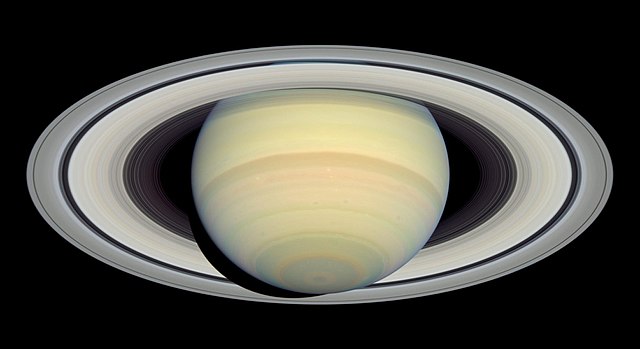
How thick are Saturn’s rings? The rings of Saturn are incredibly thin. They are only about 10 meters thick.
Saturn is a massive planet. It is the second largest planet in the solar system and is 95 times larger than Earth. It is a gas giant, but it could have a solid cure. It has a ring system consisting of 10 rings with gaps between them. The rings are, in order of closest to Saturn, the D ring, C ring, B ring, A ring, F ring, Janus / Epimetheus ring, G ring, Pallene ring, E ring, and Phoebe ring. The gaps between the rings are either caused by the presence of a moon, or by a natural balance in the rings.
The D ring is the closest. Its inner side is about 8,700 km above the planet’s surface. The farthest ring of the main ring system is the E ring and its outer edge is about 480,000 km from Saturn’s surface. There is another ring called the Phoebe ring that is about 13 million km from the surface. It has been caused by impacts with the surface of Saturn’s moon, Phoebe, and the ring follows the moon round.
There are two theories as to how the rings formed. The first theory is that the rings were made by a moon of Saturn that came too close to the planet and was ripped apart by its gravity. The moon would have orbited, but it may have been affected by the other moons around Saturn and its orbit could have decayed. If it got too close to Saturn it would have been ripped to pieces and those pieces could have formed the ring. However, if that were true, there would be rock and other debris amongst the ice. It is possible that the majority of the planet was swallowed up by Saturn and only the water layer of the moon ended up as the rings.
The second theory is that the rings were made from the leftover nebular material when Saturn formed. However, studies have shown that the rings are not as old as the planet. Saturn formed, along with all of the other planets, about 4.5 billion years ago. The rings are probably less than 300 million years old. Astronomers know this because the rings are constantly losing matter to space. From the rate of this loss, they can calculate how old the rings are and they can also calculate that they will probably have disappeared in another 300 million years. Because the rings are much younger than the planet, it makes it difficult to argue that they were formed of the same material.
Despite being so big, the rings are mostly only about 10 m thick. They do have some pieces that are about 1km in size, but most of the particles are between 1cm and 10m in size. The rings are made almost entirely of water ice. How can they be hundreds of thousands of kilometers wide yet only meters thick? What makes them so flat? It all comes down to the way the particles in the rings collide with each other. If we take the theory that the rings were formed by the destruction of a moon, then the initial particles that go into orbit around Saturn would have a lot of energy. Over millions of years, those particles collide with each other and every time they do, they lose some of their energy. After a certain amount of time, they have lost almost all of their energy and the ring becomes flat.
A lot of the planets in our solar system have rings. Jupiter, Uranus, and Neptune all have rings as well. The reason we can see Saturn’s rings so clearly is because they are made of water ice, which is highly reflective. The rings on Jupiter are made of some ice, but they also contain an enormous amount of small dust particles that scatter the light. The rings of Uranus and Neptune are made of icy chunks, but the ice is darkened by dust and rock. The rings on these planets are also much farther away from the sun than Saturn, so they have less sunlight to reflect.
So, Saturn’s rings are incredibly thin because the particles collided with each other until all their energy was gone and they orbit in the same direction. The rings are slowly being lost because they are pulled down into Saturn. And this is what I learned today.
Sources
https://astronomy.stackexchange.com/questions/21348/why-only-saturn-has-visible-rings
https://en.wikipedia.org/wiki/Rings_of_Saturn
https://solarsystem.nasa.gov/planets/saturn/in-depth/
https://news.mit.edu/2022/saturn-rings-tilt-missing-moon-0915
https://now.northropgrumman.com/saturns-rings-are-disappearing
https://slate.com/technology/2014/05/saturn-s-rings-to-scale-thinner-than-paper.html
https://www.syfy.com/syfy-wire/just-how-thin-are-saturns-rings
https://physics.stackexchange.com/questions/6545/why-are-saturns-rings-so-thin
